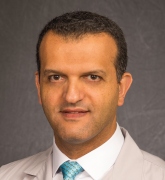Long-Term Hemodynamic Effects After Carotid Artery Revascularization. Journal Article
Local Library Link: Find It @ Loyola
| Authors: | Lim, S; Javorski, MJ; Nassoiy, SP; Park, Y; Halandras, PM; Bechara, CF; Aulivola, B; Crisostomo, PR |
| Article Title: | Long-Term Hemodynamic Effects After Carotid Artery Revascularization. |
| Abstract: | OBJECTIVE: The baroreceptor at the carotid body plays an important role in hemodynamic autoregulation. Manipulation of the baroreceptor during carotid endarterectomy (CEA) or radial force from carotid artery angioplasty and/or stenting (CAS) may cause both intraoperative and postoperative hemodynamic instability. The purpose of this study is to evaluate the long-term effects of CEA and CAS on blood pressure (BP), heart rate (HR), and subsequent changes on antihypertensive medications. METHODS: A retrospective chart review was performed to identify patients who underwent CEA or CAS between 2009 and 2015 at a single tertiary care institution. Baseline demographics and comorbidities were recorded. Operative details of the carotid artery endarterectomy and the use of balloon angioplasty during the CAS were analyzed. Hemodynamic parameters such as BP, HR, and antihypertensive medication requirement were evaluated at 3, 6, 12, 24, and 36 months. RESULTS: A total of 289 patients were identified. The average age was 70.6 years old, and males constituted 64.0%. All patients had moderate (>50%) to severe (>70%) carotid stenosis. Of those, 111 (40.5%) patients were symptomatic. Systolic BP (mm Hg) of CAS and CEA were similar over the entire follow-up period. Heart rate (beats/min) remained stable postoperatively. A reduced number of antihypertensive medications was observed in the CAS cohort during the first postoperative year when compared to the preoperative baseline: 2.03 at preop, 1.77 ( P .01) at 3 months, 1.78 ( P = .02) at 6 months, 1.77 ( P = .02) at 12 months, 1.86 ( P = .09) at 24 months, and 2.03 ( P = =.50) at 36 months. Logistic regression analysis identified that CAS (odds ratio [OR]: 2.52, confidence interval [CI]: 1.09-5.83) and multiple (>2) antihypertensive medication use at baseline (OR: 5.89, CI: 2.62-13.26) were predictors for a reduction in the number of antihypertensive medications following carotid revascularization. CONCLUSION: Surgical intervention for carotid stenosis poses a risk of postoperative hemodynamic dysregulation. Although postoperative BP and HR remained relatively stable after both CAS and CEA, the number of postoperative antihypertensive medications was reduced in the CAS cohort for the first postoperative year when compared to baseline. Patients with multiple antihypertensive agents undergoing CAS should have close postoperative BP monitoring and should be monitored for a possible reduction in their antihypertensive medication regimen. |
| Journal Title: | Vascular and endovascular surgery |
| ISSN: | 1938-9116; 1538-5744 |
| Publisher: | Unknown |
| Date Published: | 2019 |
LUC Authors
-
 4
4Park -
 35
35Aulivola -
 12
12Crisostomo -
 24
24Halandras -
 37
37Bechara
Related LUC Article
